Lethal Company is a game of survival against the terrifying monsters that want to kill you. Here’s the complete bestiary of Lethal Company, with all monsters listed.
Lethal Company Bestiary: All Monsters Listed
The bestiary below combines the information you’ll read about these Lethal Company monsters in the terminal on the ship and real-life experience. That experience includes how these monsters act, their hostility level, and how to deal with them whether that’s by avoiding them or by killing them.
To get monster profiles, be sure to use your radar when encountering a new monster. This will upload the monster data to the terminal on your ship, which you can access whenever you’re onboard.
To access the bestiary, approach the terminal in the ship. Type in the command ‘Bestiary’ and press enter. This will open a new page. Once you’re on this new page, just enter the name of the monster whose information you’ve gathered through scanning.
Roaming Locusts
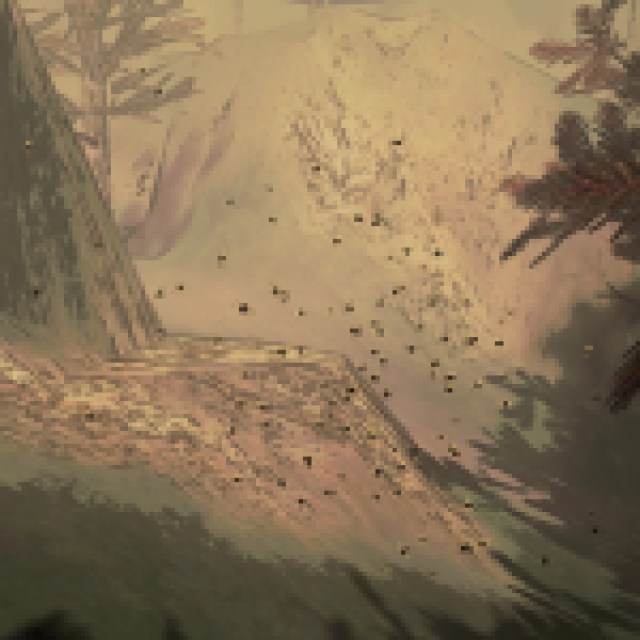

Roaming Locusts are passive creatures that can frequently be found outside. They’re likely to be one of the first creatures you find once you step outside onto a new moon. If you approach them, they’ll likely fly away.
Bestiary Entry for Roaming Locusts
“Known as roaming locusts, this is a species of grasshopper. Unlike some species which are more prone to jump or fly, roaming locusts are almost never grounded and stay close together even when in smaller numbers. They will quickly disperse when a predator disrupts them but are highly attracted to light.”
Manticoils
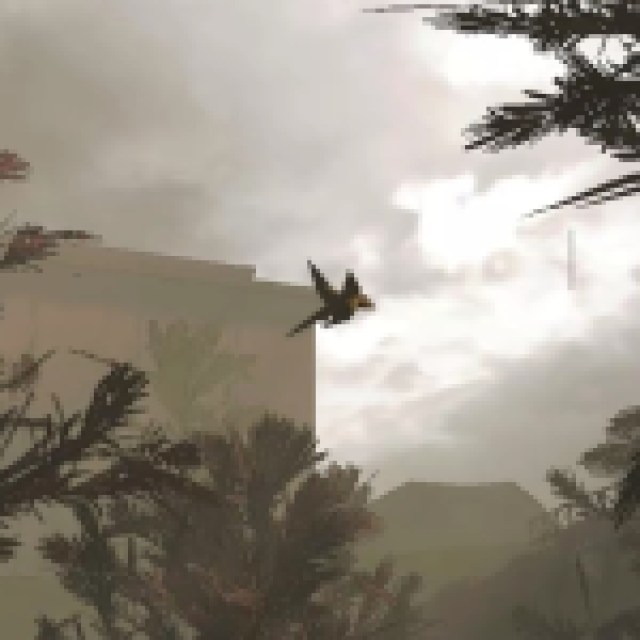

You’re most likely to encounter Manticoils outside, where they’ll be flying in the air, usually in small groups of three or more. You’ll see them on the early moons you explore in the morning. These Lethal Company monsters pose no threat and will fly away if you approach them.
Bestiary Entry for Manticoils
“Mantacoils are a passerine bird of the family corivdae. Their bodies are quite large compared to their early descendants, and their wingspan ranges from 55 to 64 inches. Their most defining characteristic is their set of four wings. Their back wings are mostly used to stabilize when at low speed, while their front two wings create the majority of lift. Their round bodies are a striking yellow but with black outlines or stripes along their primary (rear) feathers.
Manicoils mostly feed on small insects but can also feed on small rodents. They are highly intelligent and social. They pose little threat and generally have a passive tempermanet towards humans, although they are capable of transmitting Rabies, Rubenchloria, and Pitt Virus.”
Circuit Bees
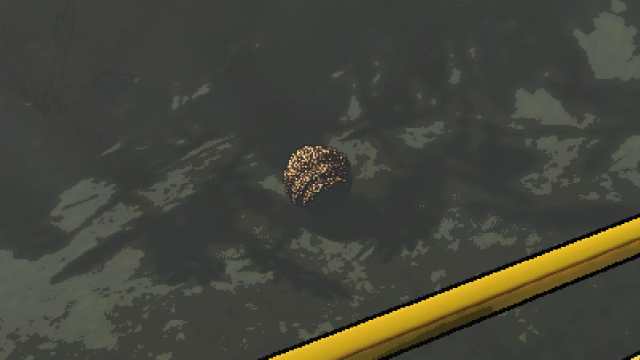
As you might expect, the Circuit Beehive is worth quite a few credits. Usually, around 100. Two or more players can steal a hive by having one player approach the hive. Once the bees swarm that player, a second player will then need to go in and grab the unprotected Beehive.
However, the bees will remain in a hostile state with their hive gone. They’ll continue to swarm around the outdoor map, looking for either a player to chase or their hive. Return to your ship and close the door to avoid being stung to death.
Bestiary Entry for Circuit Bees
“The circuit bee, also known as red bee, is a eusocial flying insect of the genus Apis, a descendant of the honey bee. Their appearance is quite recognizable form their hairy, red bodies and two sets of wings. Like their ancestors, they are well-known for their intelligent social BEEhavior, large colony size, building wax nests which they use to store honey, and their important role in pollination. Unlike the honey bee, which often chose high places such as trees to construct its hive, red bees create their hives on the ground.
Red bees are highly defensive. They will leave the nest to attack any creature that comes within several meters, leaving BEEhind only the queen and drone bees. This bold BEEhavior is enabled by their most defining aBEElity, which is their electrostatic charge. Red beeds produce friction with the air. They also produce firction by rubbing their two pairs of wings against each other any by rubbing against one another while in the hive.
What allows them to create such a surplus of electric field compared to the honey bee is still under research, as they generate a stronger electric field when panicked or angered. This ability is especially useful for them around water.
It’s BEEst to keep your distance. If a red bee hive is stolen, red bee swarms will enter an onslaught in which they attack any living creature. This destructive BEEhavior will last until they have located the hive or completely exhausted themselves, which can take hours to days. They have BEEn known to leave BEEhind fields of bodies of small rodents, insects and even some larger mammals, and in rare cases they can start fires. Their strong BEEnefits and drawbacks to their ecosystems are highly debated. BEEbated !! – the indomitable Sigurd”
Hoarding Bugs
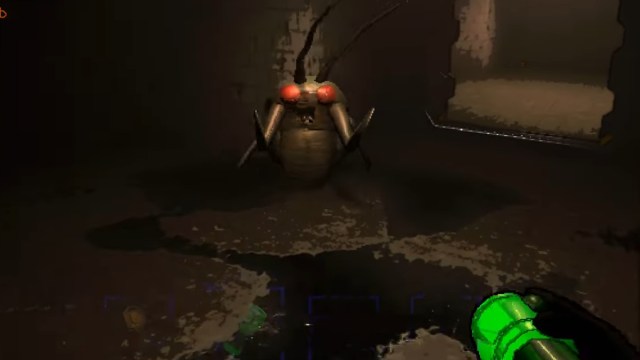
Hoarding bugs do precisely as their name implies. They hoard. They’ll run around the map, gathering items in direct competition with you, and take them back to their nest. While they’re gathering, they’re harmless and non-hostile. However, if you attempt to take the items from their nest, which you can find by chance or by following them, they will become hostile. They’ll leap at you to do damage, but the damage is not substantial.
While Hoarding Bugs are easy to dispatch with a shovel or stop sign, be wary of the fact that they usually come in groups of one to three.
Bestiary Entry for Hoarding Bugs
“Hoarding bugs (of the order Hymenoptera) are large, social insects. While often found living alone, they have been found to share their nests with members of their own species. They measure a height of 3 feet on average, with bulbous bodies. The thinness of their fluid and blood and the material of their carapaces contribute to their low weight, making them capable of flight with their membranous wings. It also makes their bodies somewhat transparent.
Hoarding bugs were given their name due to their territorial nature. Once they have chosen a place as their nest, they will seek to adorn it with any object they can find and will protect these objects as part of the nest. Hoarding bugs are not so dangerous alone as they are in large hives. However, if left alone, hoarding bugs are surprisingly neutral and pose little danger. We love the stupid cuddle bugs.!! – this has been a note from the indomitable Sigurd”
Snare Fleas
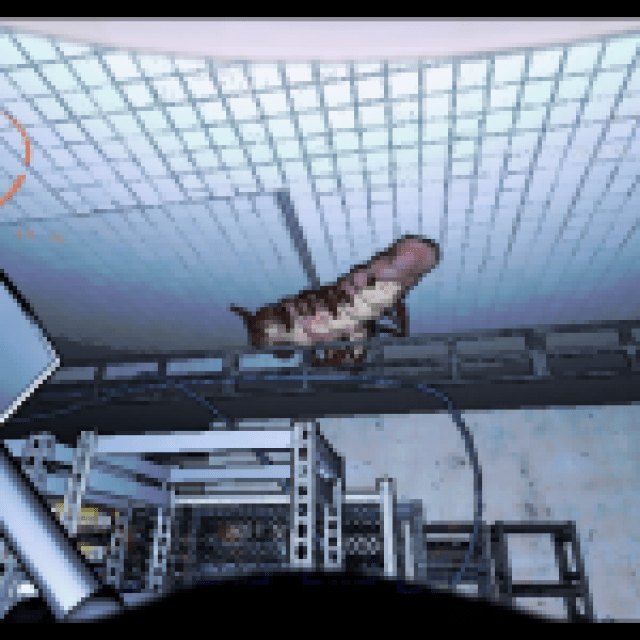

You’re very likely to encounter Snare Fleas while exploring indoor maps. For that reason, if you know you’re going inside, it’s a good idea to have several members of your team hold a flashlight which you’ll need to keep trained on the ceiling. That’s where they lurk.
If a player walks beneath a Snare Flea, it will drop down and chase the player. If it catches the player, it will leap onto their head, where it will blind them, muffle their voice, and slowly start to drain their health. This is lethal unless you have a crewmate around.
If you do have a teammate nearby, they can knock the Snare Flea off the affected player’s head with a shovel or stop sign. One hit should do to cause the Snare Flea to unlatch itself. You’ll need to kill the Snare Flea or it will return to the ceiling where it will try to ambush you again. Alternatively, you can walk outside with a Snare Flea on your head and the Snare Flea will immediately unlatch.
Bestiary Entry for Snare Fleas
“A very large arthropod of the class chilopoda. Its body produces a silk which it primarily uses to propel itself to places where it is concealed. Its exoskeleton is somewhat fragile, and they can die from long falls. The snare flea does not produce venom, nor does it have a strong bite. It makes up for this weakness with its ability to tighten itself around large prey to suffocate.
The snare flea thrives in dark, warm areas. It cannot survive low temperatures and generally avoids open air and sunlight take the rats outside or just beat the hell out of them! I think their insides could make a good milkshake.”
Spore Lizards
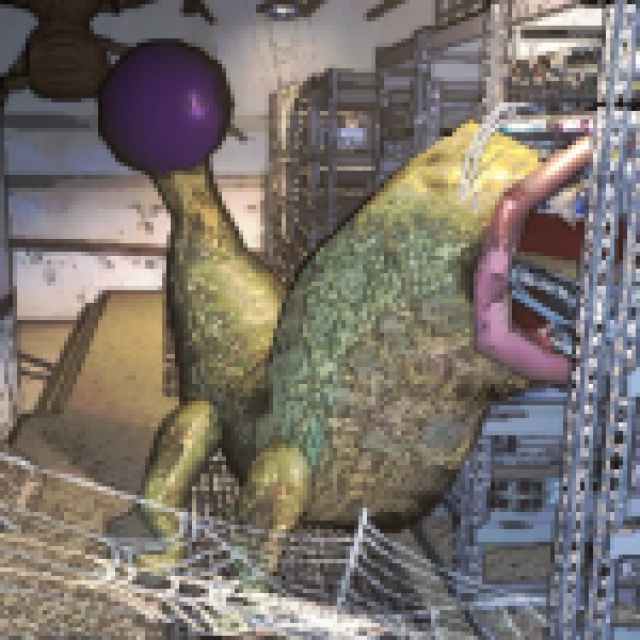

Spore Lizards are largely harmless creatures that are more silly than dangerous. They’re adorable, really, and non-hostile. If you approach it, it will run away. But if it’s trapped with you indoors, it may bite you for a small amount of damage or release a puff of pink spores. These pink spores can hinder visibility, but they’re not harmful.
Bestiary Entry for Spore Lizards
“Colloquially named puffers or spore lizards, Lacerta-glomerorum (of the family Alligatoridae) is one of the largest and heaviest reptiles. Despite their large mouths, they are herbivores and do not have a strong bite. The bulbs on their tails are believed to secrete a chemical which attracts and accelerates the growth of the fungus species Lycoperdon perlatum, which it can then shake to release spores as a defense mechanism–an unique example of a mutualistic symbiotic relationship.
Spore lizards have a very timid temperament, tending to avoid all confrontation if possible. If their attempts at threat display are not effective, they may attempt to attack, so it’s not recommended to corner or chase one. There are historical records that spore lizards were at least partially domesticated hundreds of years ago, however, this effort was set aside by an initiative to harvest their tails for their medicinal properties.”
Hygroderes
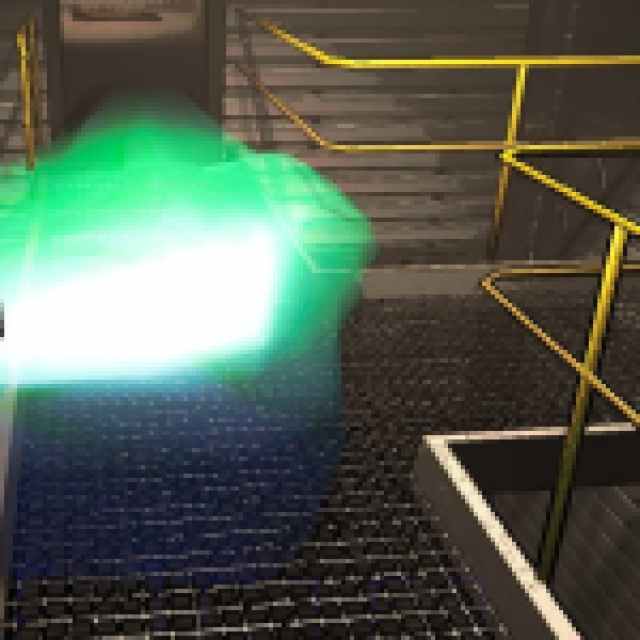

While the Hygrodere might be immune to all types of damage, it can only affect you if you touch it. Thus, a good way to counter the Hygrodere is to simply jump over it. It’s recommended that you not hit them, as this turns the blue haze hostile, causing it to move faster.
Bestiary Entry for Hygroderes
“A eukaryotic organism classified within the paraphyletic group Prostita. With the incredible speed of reproduction, these small organisms can multiply to millions. Hygrodere rarely split apart, instead choosing to form large, viscous masses which can take up large amounts of space and become a danger to deal with, requiring large tools or lures to relocate.
Hygrometry are drawn to heat and oxygen and can detect it from seemingly anywhere. There’s almost nothing organic they can’t convert to their own body mass. Nothing has been found to poison them. Constantly replacing themselves, they can persist for hundreds of thousands of years. If you ever find yourself cornered, find a tall object to stand on top of; hygroderes have trouble climbing. they have great taste! cause I made a friend with one somehow, and we think it was my music.”
Bunker Spiders
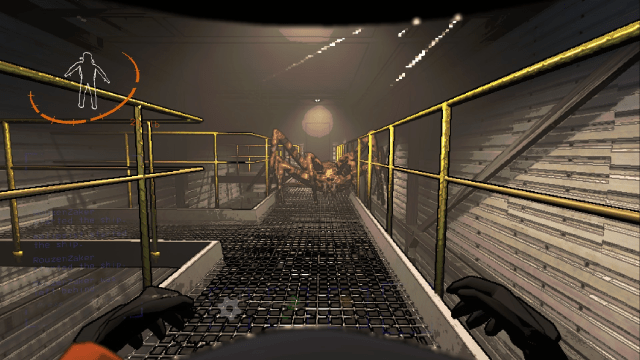
Bunker Spiders are one of the most terrifying things in Lethal Company and are commonly found indoors. Fortunately, they’re easy to counter. Be sure to have a shovel or stop sign and a railing you can jump on nearby. Then, trigger the Bunker Spider and get it to chase you back to your railing. Jump on the railing, then beat the spider to death with your shovel.
Bestiary Entry for Bunker Spiders
“Bunker spiders, of the genus Theraphosa, are the largest arachnid found in the Thistle Nebula and the second largest ever discovered. It’s believed they evolved to prey on large mammals over the course of a measly several hundred years after the Boat made its trip around the Thistle Nebula. (Refer to: Speculation on Increased Speciation Around the Fading Nebulae)
Bunker spiders produce silk and lay it around their chosen nesting area, then wait for it to be tripped on. They can be seen waiting on walls, often over doorways where prey could enter unaware. If you find a bunker spider ‘unprepared’ it may freeze as a defensive reaction. In this case they are best left alone. If a bunker spider reacts aggressively, it is best not to fight with ordinary tools. They use their webs to make up for their rather slow movement, so take note of your surroundings. Their webs can be broken easily with any blunt tool.
Bunker spiders can pose a great danger to humans and urban explorers especially, without a great benefit to their ecosystems. A resulting kill-on-sight order has been informally agreed upon between many states home to the Bunker spider, and it is currently approved by the ITDA as of 10/6/2497.”
Bracken / Flower Man
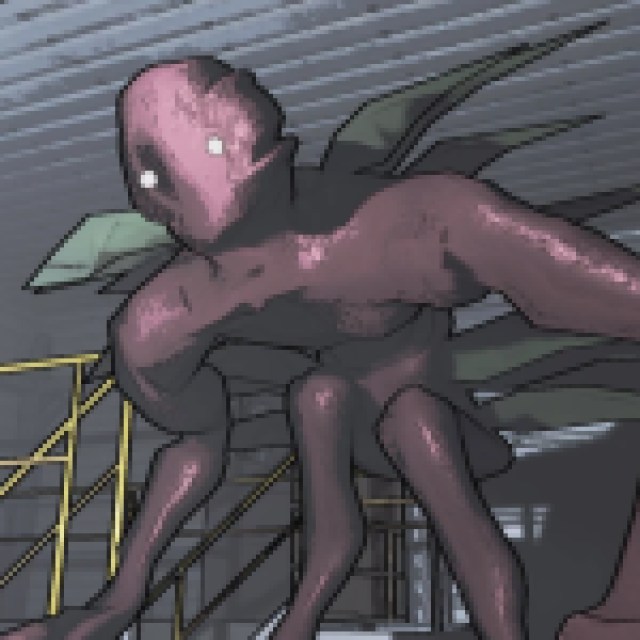

Bracken, otherwise known as Flower Man, is an extremely dangerous creature that’s very hard to kill and seems to appear on all dangerous moons. They’re immediately identifiable by their tendency to stare out at you from the dark with a pair of white eyes.
If you see a Bracken in a more lighted area, you’ll see that it’s humanoid, red, and with a series of leafs running down the length of its spine. Bracken prefer to silently stalk players and, if not stopped, will snap your neck while you’re not looking.
To prevent this, you must glance at the Bracken briefly. Do not stare, and do not approach a Bracken. Doing so will turn the Bracken hostile. But if you effectively use the glance and run away method, the Bracken will back away from you for a period of time. Bracken have favorite rooms, usually places as far as possible from the exit, where it will keep players that it has killed, making body retrieval difficult.
You can kill the Bracken using a combination of stun grenades or the zap gun and a shovel. You’ll need to stun the Bracken then beat it to death with a shovel, with the hit count being around 5 to 6 smacks.
Bestiary Entry for Bracken
“There is debate on the genus to which the Bracken belongs. It is a bipedal vertebrate with skin the color and texture of a red beat. The name was coined for what appear to be leaves protruding from its upper spine. The purpose of these is believed to be for intimidation, however not much is known about the specifics of bracken behaviour due to its illusiveness and low population.
We know a little from accounts by wildlife experts who have encountered it. is a lone hunter with high intelligence. Its behavior can seem aloof; it exhibits high aggression even when unprovoked, yet it quickly backs off when confronted. However, brackens are known to up their hostility when cornered or simply watched for a long time. For this reason it’s recommended to keep an eye on it but not to stare it down. No specimens have been collected dead or alive. It’s theorized that upon death their bodies undergo a rapid decomposition process which is unique from other large animals.”
Thumpers
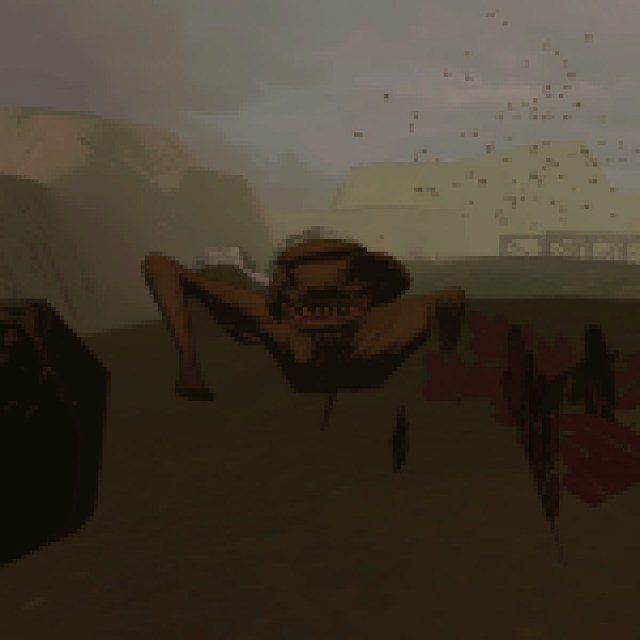

Thumpers are enemies that you should do your best to avoid as you gather resources. The best way to do this is to be aware of the dragging and stomping noise that accompanies Thumpers as they move through complexes. If you stumble across a Thumper, you’ll know you’ve gotten its attention because it will roar. Once it roars, it will begin a slow crawl towards you, which will quickly accelerate into a tackle.
You have between the roar and the slow crawl to quickly turn down another corridor where it doesn’t have a direct line of sight. From there, you should do your best to continue to make turns to ensure that the Thumper loses track of you completely.
However, you can kill them the same way you kill Bunker Spiders. Just jump up on a railing and hit it with a shovel. But note, you may have to hit it five or more times to bring it to heel.
Bestiary Entry for Thumpers
“Halves, or Thumpers, are a highly aggressive, carnivorous species of the order Chondrichthyes. Their skeletons are cartilaginous, giving their bodies a stretchy and rubbery quality. Their name comes from the fact they must eat their bottom legs in order to escape the shell of their hatched egg; their bottom legs are hardly functional to begin with. Their arms, or front legs, are very strong, and they occasionally use them to stomp prey. They can reach great speeds in a straight line.
They are relentless hunters, typically at the top of their food chain. Their main weaknesses are their intelligence and complete lack of hearing. If you come across a thumper, your best means of survival are leaving its line of sight, as it is slower around corners and can’t easily track prey.
Due to the fast and volatile evolution of this species, some theorize that thumpers are one of the examples of increased number of mutations.”
Coil-Heads
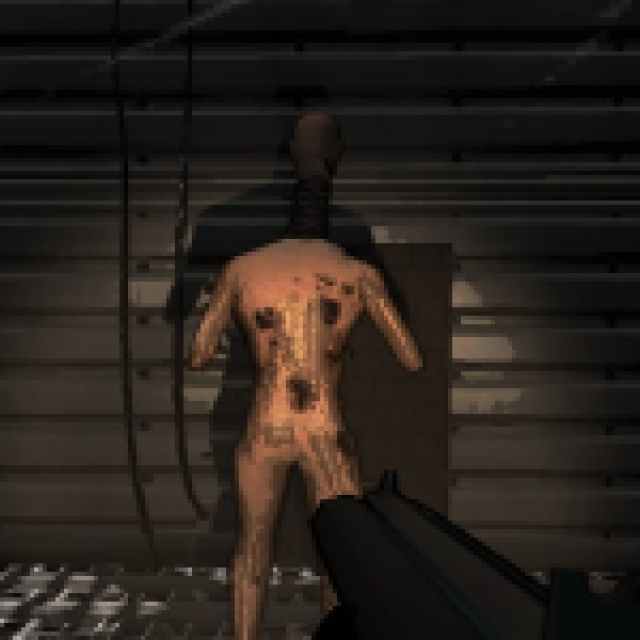

Coil-Heads are a straightforward enemy on paper. By staring at them, they’ll stay stationary, at least mostly. Sometimes, they’ll dash forward a few feet towards you. For this reason, it’s always a good idea to keep a few feet between you and it. Coil-Heads are at their most annoying when dealing with multiple enemies or when they’re blocking an area.
If you’re fighting multiple enemies, have a teammate stare at Coil-Head as their primary job. To get past a Coil-Head, you can edge past them while staring at them. Just don’t touch them. If they’re blocking an area you need to get through, you can choose to back away and then look away in order to get them to chase you. You can do this until you’re in an open area and moving around the Coil-Head is easier.
Doors are also an effective deterrence to Coil-Heads.
Bestiary Entry for Coil-Heads
“Vir colligerus, or colloquially named Coil-heads, have not been studied extensively due to their extreme unpredictability and dangerous properties. They have been known to combust into flames when being dissected or even deactivated, and they carry dangerously high levels of radioactive particles. Due to this and other reasons, it has been highly speculated they were created as biological weapons of war, although this has not been proven.
Coil-heads’ visual appearance is that of a bloody mannequin with its head connected by a spring. Their defining behavioral characteristic is to stop when being looked at. However, this does not appear to be a hard-and-fast rule. When they encounter a loud or bright light they sometimes appear to enter a long reset mode.
Just stare at them or use a stun grenade! – Sigurd”
Jester
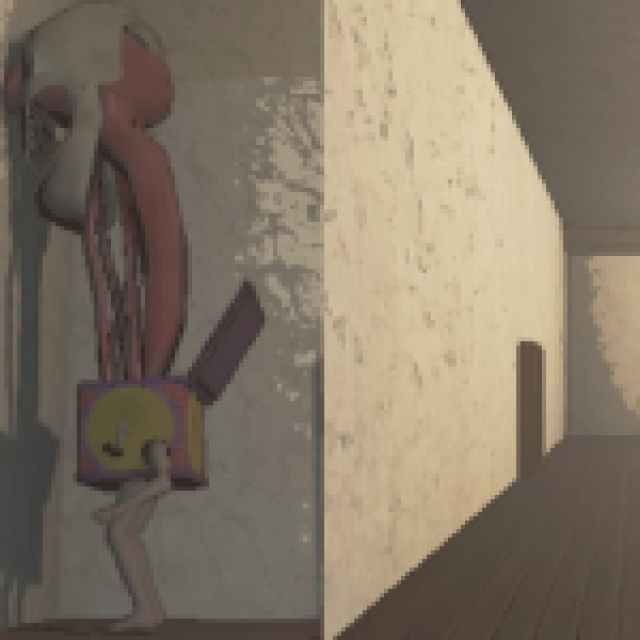

So, as you might have gathered from Sigurd’s notes, the Jester is a difficult enemy. It can only be found on hard moons or very rarely on other moons. It’s essentially a walking Jack in the Box.
Jesters have three states. The first state is its passive state, where it’s waiting to encounter a player. It will wander around the map during this time.
Once a player is found, the Jester will begin following the player. Eventually, it will enter its second state. The second state will have the Jester use its arm to turn its crank. It will then begin playing the song ‘Pop Goes the Weasel’ which will become progressively faster as it cranks.
Its final stage occurs once the song ends. A monstrous head will pop out of the Jester’s box and it will begin chasing players through the complex. It does not need to see you to find you. The Jester will not stop pursuing players until all the players are dead or until they leave the building for approximately five seconds. Once players leave, the Jester will return to its boxed state.
Once you realize a Jester is in the vicinity and following you, you should immediately begin planning your exit. That exit should be taken once it reaches its second phase.
Bestiary Entry for Jesters
“Get out of there before it goes APE!! You cant hide from it, just evacuate
THERE’S NO FREAKING SCIENTIFIC RECORD! good luck, you know as much as us. We just call it the jester!”
Red Girl / Ghost Girl
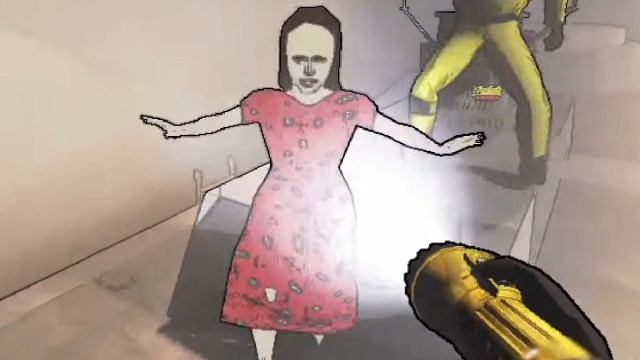
The Red Ghost Girl of Lethal Company is one, if not the only, monster that can’t be scanned and thus doesn’t have an official bestiary profile. She can be found both indoors and outdoors and is a lethal threat.
The Red Ghost Girl, when encountered, is only ever visible to one player at a time. The haunting will begin with the Ghost Girl appearing before the affected player, the player experiencing flickering lights, their hearing becoming muffled and distorted, and hearing giggling and heavy breathing.
The Ghost Girl can’t be escaped and can appear both inside and outside of the complex. And, eventually, it will leave the Haunting state and begin its hunt state.
During this phase, the Red Ghost Girl will begin skipping towards the chosen player. If she touches that player, that player will die. The affected player must then dedicate their resources and time to running from her. If they do die, the Red Ghost Girl will then begin haunting a new player. Thus, it’s a good idea to let the affected player keep her occupied while the rest of the team gathers resources.
Forest Keeper
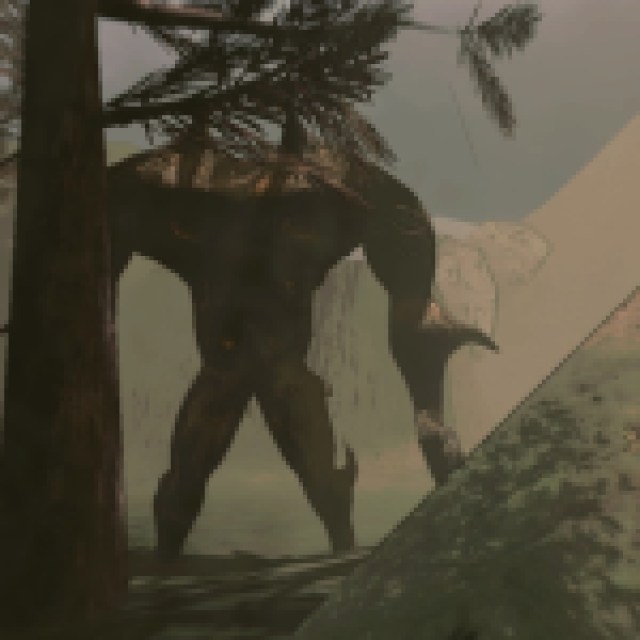

Forest Keepers, or Giants as the community prefers to call them, are found outside at night. They’re extremely noticeable if they’re moving, as they’re quite large. But, when they’re stationary, they can blend in with the trees.
Giants are a lethal threat if they sense you. Once they’re aware of your presence, they will attempt to pick you up and eat you. Once you’ve been eaten, that person and their resources should be counted as lost. However, Forest Keepers are only aware of motion. Thus, the best way to avoid them is to crouch and move slowly out of their line of sight.
Bestiary Entry for Forest Keepers
“Believed to share a common ancestor with rapax-folium, these behemoths are called Forest Keepers for the biomes they often inhabit. Their bodies bare markings on their front and back which mimic eyes–this trait is more helpful in their youth, as they are not agile. Their skin is a unique, dense material which hardens further throughout their lives; the large spikes and bumps across their bodies form as a result of aging.
It’s been said Forest Keepers exhibit a curious behavior similar to that of a human child the age of 5 or 6. They will eat anything they find fascinating. Forest Keepers don’t actually need to put anything into their mouths, and it’s theorized their main source of energy is a process similar to photosynthesis. Still, this makes them relatively dangerous to observe. They can see across long distances, so staying low and making use of cover is a must. They cannot enter small spaces and are not generally destructive, so stay close to shelter or overhangs.”
Eyeless Dogs
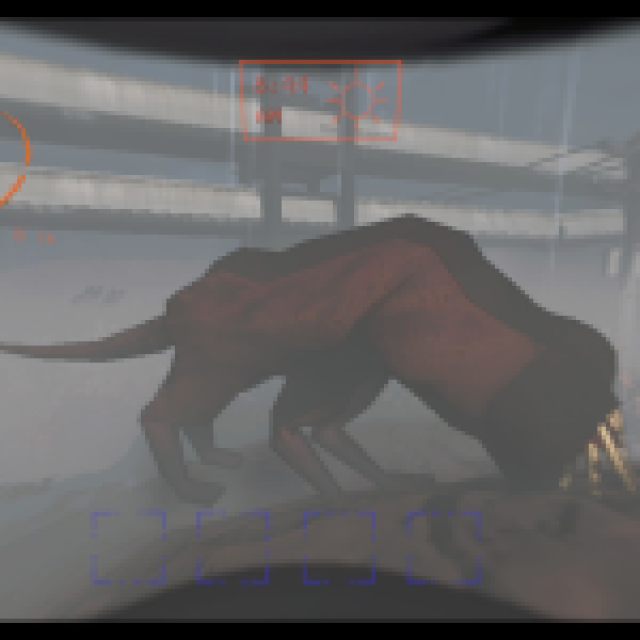

Eyeless Dogs, as their names imply, are blind. Thus, they rely heavily on touch and sound. Sound includes, unfortunately, mic input. Once an Eyeless Dog has been made aware of your presence, it will roar and begin dashing and investigating the area where it heard the noise. If it finds you, it will grab you in its giant mouth and shake you like an oversized dog toy.
An Eyeless Dog’s roar will notify all other Eyeless Dogs in the area.
To avoid this, keep quiet comms, stay crouched, and move slowly to get past them. If a pack of Eyeless Dogs is blocking your way, you can order an item. Its delivery will distract the dogs to that area. Just make sure it’s not a high-value item you’ll regret not being able to get.
Bestiary Entry for Eyeless Dogs
“Saeptivus. They are social, hunting in very large packs. They have also been called “breathing lions” for their recognizable sound and large mouths. They are endurance hunters and attempt to make up for their lack of sight with their sense of hearing. It’s a popular myth that they often mistake the sounds of their own kind for prey, entering fights within their own packs.
Their behavior is unique from other pack animals in their tendency to spread out far to cover distance. When an eyeless dog has found prey, it roars to alert others in the near vicinity, who will also sound the alarm, sometimes resulting in a kind of chain reaction. Eyeless dogs can be dangerous in swarms. However, they are characteristically clumsy, taking guesses at their prey’s exact location which are often incorrect.”
Earth Leviathan
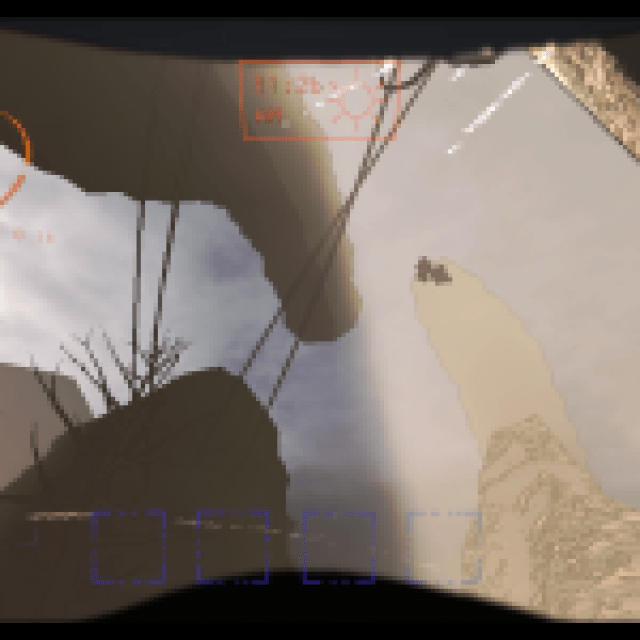

Are you really in space if there isn’t a giant carnivorous earthworm beneath the sands? Earth Leviathans can only be found outside and only detected using the radar inside the ship. While using the radar, you’ll be able to see a giant red dot. This red dot indicates the Earth Leviathan.
They will target players who are outside. Once they have a player in their “sights” they’ll roar, though the sound will be muffled by dirt. The ground will begin to rumble, signifying the Earth Leviathan’s ascent. The player must then run or retreat back the way they came in order to avoid the Earth Leviathan. If they fail to do so in time, it will swallow the player and the items they were holding, killing them instantly.
Rocks are not safe while you’re in range of the Earth Leviathan’s attack.
Bestiary Entry for Earth Leviathan
“The reverently named Earth Leviathan, of the family Piscicolidae, is one of the largest invertebrates found around the Thistle Nebula. None have been captured, so not much is known of their biology.
They seem to behave as predators. It’s speculated they can burrow as far as 40 meters underground, judging by the incredible excavations they can leave behind. They can detect even the slightest vibrations, and for this reason it’s not recommended to stay still if they are nearby; that is a myth. Instead, if you hear them burrowing, retrace your steps.”
Baboon Hawk
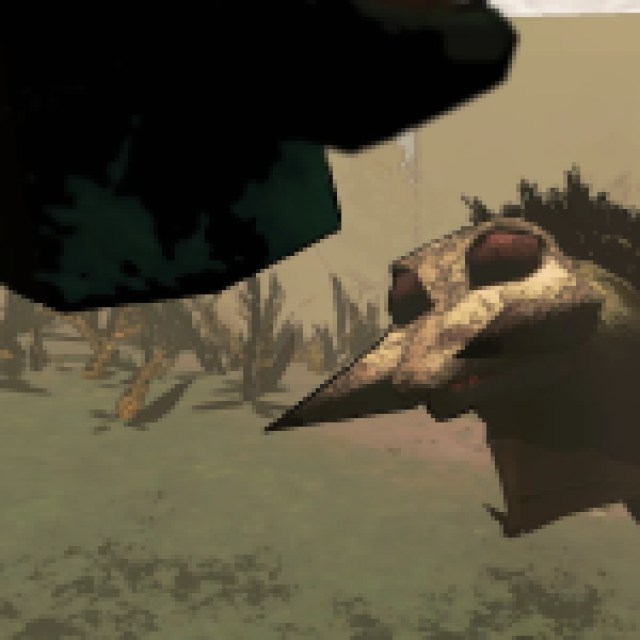

Baboon hawks, as their name implies, are a combination of baboons and hawks. You’ll see them jumping along the ground with their stout back legs, but they maintain both wings and a sharp beak, which it will use to attack anyone who comes too close.
In general, Baboon Hawks will only become aggressive and attack you if they outnumber you and you enter their territory. But, if you and your team outnumber them, they’ll tend to stay away. But if you wander off alone while in their territory, they will attack. They tend to follow players and are very difficult to kill.
if you must walk through Baboon Hawk territory and happen to be outnumbered, the best thing you can do is to sprint through them to safety. Dropping a stun grenade can buy you time. But because they can take approximately seven blows with a shovel to kill and are almost always in packs, it’s not recommended you try and kill them. They will likely overwhelm you.
Bestiary Entry for Baboon Hawks
“Baboon hawks are a primate of the family Cercopithecidae. They are hunchbacked but can stand up to 8 feet on average. Their heads are boney, with bird-like beaks and long horns, which they use like skewers to gore and feed on prey. Their horns are made of keratin instead of bone like the rest of their skulls, and they do not contain nerves or blood vessels. As a result, baboon hawks can often break their horns from the force they apply, then fully regrow them within the same season. Baboon hawks partly owe their name to their large wings, which could never carry their large body mass and are used instead for intimidation and protection from the elements.
The largest baboon hawk troop ever observed was made up of 18 baboon hawks. They are loosely territorial, and much of their behavior is motivated by intimidation and display. They can become collectors, using any flashy or colorful object to mark their territory. As lone scouts, baboon hawks are generally timid and won’t attack unless provoked. In greater numbers they can become a great danger; sticking close to others and making yourself seem dangerous is the best ways to prevent an attack. They prefer smaller mammals, but when desperate, they are known to use their numbers to attack animals even twice their size, such as eyeless dogs.“
Nutcracker
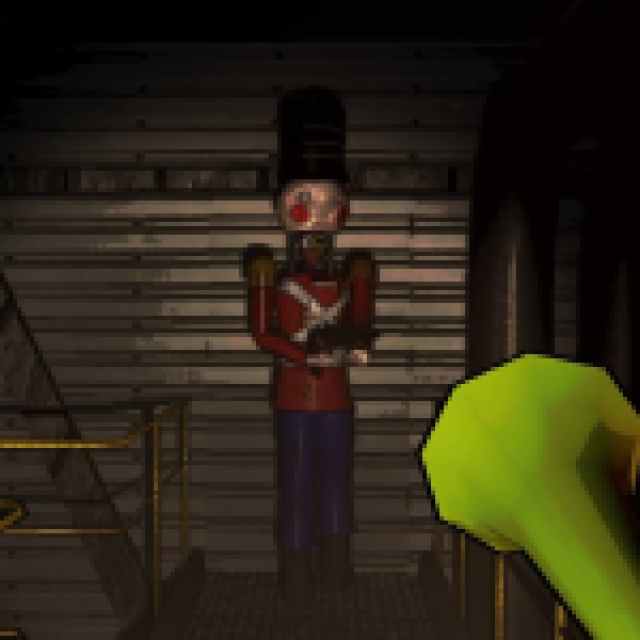

At first glance, the Nutcracker is a tall tin soldier who patrols particular moons. It is most likely to appear in 85-Rend, 8-Titan, and 7-Dine. Nutcrackers are exceptionally lethal enemies because they come equipped with Shotguns, which you can steal upon killing them.
You’ll know a Nutcracker is in your vicinity by the sound of heavy steps and a marching tune. Once you’ve located a Nutcracker, your best strategy will depend on what mode it is in.
Sentry Mode – If the Nutcracker is standing in place with its singular eye revealed (its entire head will lift up, revealing the eye where its jaw once was), you should remain completely still. This is sentry mode. The eye detects motion. Once the eye isn’t looking at you, you can approach the Nutcracker and begin beating it to death. If it sees you while in Sentry mode, it will pursue and shoot you. It’s a good idea to bait out the shots twice by using cover, like doorways. Once you’ve done this, you can beat it to death.
Patrolling Mode – If the Nutcracker is on the move, it is patrolling. If it sees you, it will chase and shoot you. Your best bet is to use cover and bait our the Nutcracker’s shotgun shots. After the second shot, the Nutcracker will be forced to go through a long animation as it reloads. This is your prime opportunity to kill it.
While trying to kill Nutcrackers, stay away from long corridors, as they afford no cover. That being said, if a Nutcracker falls backward into a wall when it dies, it might take its Shotgun with it. Thus, it’s a good idea to try and deal the final blow in an open area.
Bestiary Entry for Nutcrackers
The guardians of the house.
They watch with one tireless eye, which only senses movement; It remembers the last creature it noticed whether they are moving or not.
Masked
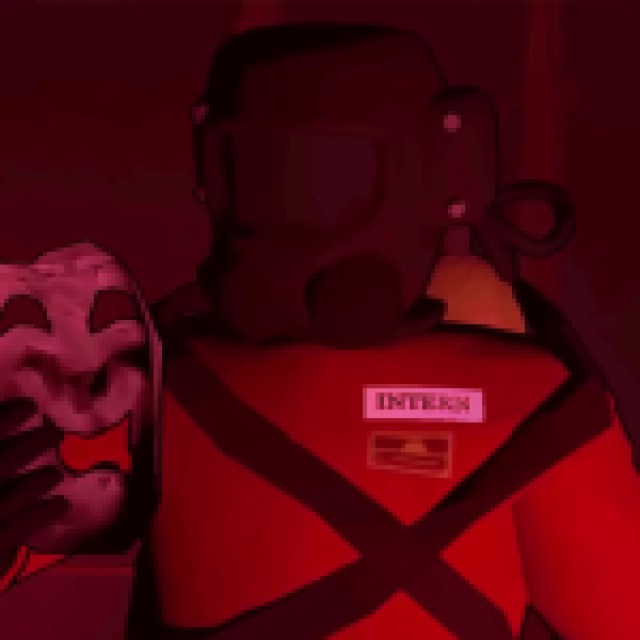

The Masked isn’t its own unique entity. Rather, it’s a state that a Lethal Company employee can take. Masks can be found on the moons 85-Rend and 8-Titan.
While on these Moons, employees may find a piece of scrap called the Mask. These Masks come in two flavors: Comedy or Tragedy, and will be smiling or frowning appropriately. The Masks are harmless until it’s held up to your face for a prolonged period of time. It’s possible that the Tragedy mask will instantaneously transform you.
Once this happens, the Mask will kill the person holding it and adhere to their face. At that point, the affected employee will lose all control and the Masked will begin hunting the other employees.
The Masked may imitate normal player behavior, like peeking corners, spinning in circles, and looking around. However, you’ll be able to tell if a person is Masked by, as you might expect, the Mask on their helmet.
You’ll know a Masked is about to attack when it reaches out toward a player with its arms extended and the lights in the mask turn red. Once this occurs, you have a very short window to escape or kill the Masked. Stun weapons will prevent the Masked from attacking for a period of time but will not permanently disable them. Thus, you should kill the Masked employee as quickly as possible.
The Masked will only attack one employee at a time, making the best way to deal with it a team effort. The selected target should run, ideally in an open area in circles, while the rest of the team beats the Masked to death. Shotguns may also work at close range.
Butler
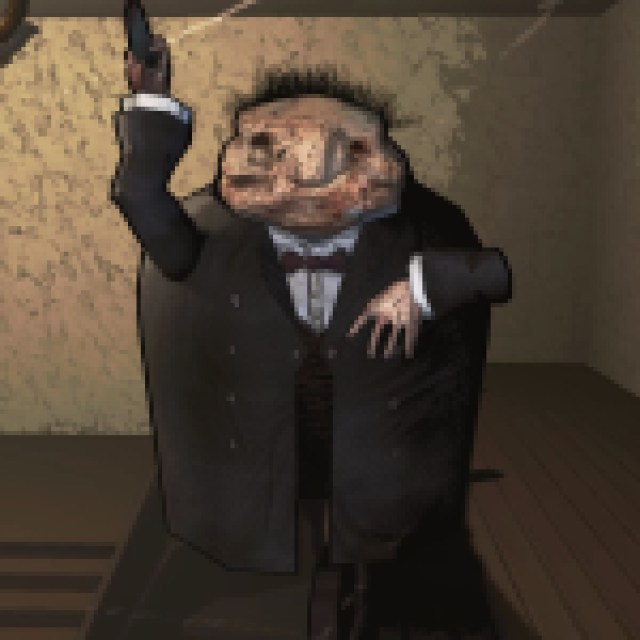

Butler is an indoor entity introduced in Version 50 of the game, which you will find inside manors and mansions. The Butler roams around the area sweeping the floor with their broom. Pretty innocent, right? Well, the true colors of Butler will show when you face it one-to-one, with no other player near you. That is when the Butler pulls out its knife and rushes at you to try to kill you. If you get killed by the Butler, it will return to its passive state and flee to the furthest room on the map.
You can also kill the Butler like any other enemy and take its knife, which you can use to attack other players and monsters. The knife you get from the Butler can also be sold as scrap to fill up the quota. Moreover, when you kill Butler, it will spawn a swarm of Mask Hornets.
Bestiary Entry for Bulter
“Theres no file on ths one so i’m MAKING it myself. we keep finding these stinky freaks in the mansion, they wont talk to us, they dont even pay attention to us and they look like deflated ballloons. the smell is like rotten meat, it’s so bad it puts richard to shame. i hear flies buzzing around inside their bodies. Jess said she saw something crawl out of its eye socket and go back in.
I don’t know what to make of this man
they just walk aroun and sweep the floor, I guess thats why the mansion is so clean. At least they do their job. But I swear the stinky freaks stare at me when I’m not looking
update: They chased Rich with a knife. we didnt see it, but he says when he got into the room, the butler just took out its broom and started sweeping like nothing happened. So we’re all sticking together from now on. Screw these butlers! Now i have to stay closer to rich and he probably pissed in his suit.”
Old Bird
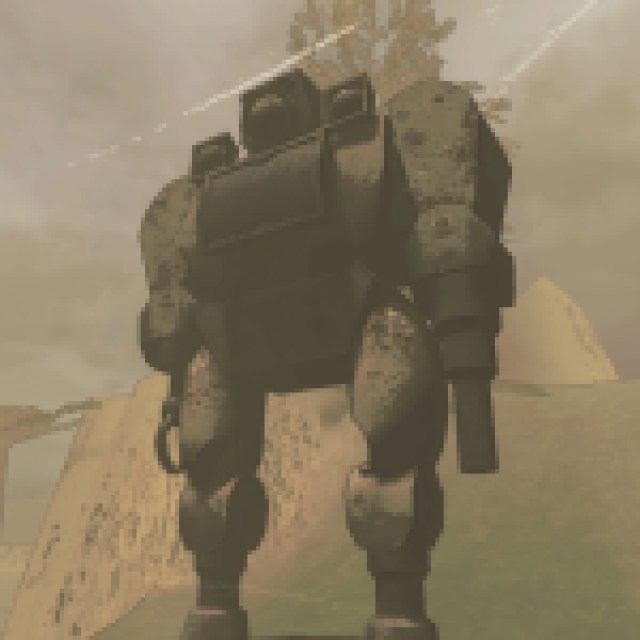

Old Bird is one of the two outdoor entities introduced in the Hopping Update, which is a giant Mech Robot that will spawn in an offline state. It will become active only after 5 PM or when you take out the core battery from the facility.
The Old Bird is equipped with a giant searchlight at its head and rockets, which it will shoot after spotting a player. Also, if you get too close to it, it will pick you up and torch you with fire, resulting in an instant death.
You can avoid the Old Bird if you get behind structures or lose their sight by going past their vision. They lose track of players and can’t turn quickly, as mentioned in the Bestiary.
Bestiary Entry for Old Bird
“The Old Bird is an autonomous, offensive weapon of war with a humanoid design. Measured at 19 feet tall and 11 feet wide, its two most defining visual features are the spotlight positioned on its head, capable of emitting 100,000 lumens, and the long-range acoustic device on its chest, sometimes referred to as a sound cannon. There are additional speakers on its shoulders used to broadcast sound a long distance. The Old Bird’s left arm is a claw, and its right arm is a nozzle capable of both launching rocket-propelled grenades and torching at close-range with a very hot flame. Old Birds are one of the first extra-orbital weapons to be used and mass-produced.
The subject of who developed the Old Birds has been an intense debate since their first recorded appearance on December 18 of 2143, when over fifty Old Birds invaded the Anglen Capital. This is considered one of the first major causes for the downfall of the Anglen Empire. The most commonly upheld theory takes into account the tension between the Anglen and Buemoch military throughout the 2100’s, however nothing has been proven in the centuries since. The design of the Old Bird, down to the tempering of metals, appears intended to conceal its origin. It has been called the “walking ransom letter.”
Old Birds’ legs function as rockets, which allows them to travel long distances and find targets efficiently. But the most likely reason this feature exists is to help them enter and land from orbit. The material and fuel Old Birds rely on is similar to those of passenger space craft from around 2130.
Old Birds land and stay at their target planet forever. Although they often have more than enough fuel for just one trip, no behavior has been found in their programming which suggests they could choose to “migrate”. Still, there are unverified accounts of Old Birds travelling autonomously to a new planet after hundreds of years of dormancy.
The Old Bird was historically referred to as the “Al”, based off the code name it was given by the English military, the “A16-L31”. In 2384, however, the song “Old Birds” released as a cult hit by the post-punk project Under Remora; just three years later, in his most famous work of the same name, street artist Land Eyrie depicted the automotons flying and landing between planets in an arrangement similar to a flock of geese–this is generally considered one of the most iconic and influential images of modern culture and solidified the modern nickname.
In 2356, 5-Embrion was classified as Condemned for the purposes of travel or settlement by the Boat; Old Birds were described by witness accounts as “lining the horizon”. Though to this day they appear inoperative, there is a reasonable risk that many are still in sleep mode, so the planet will likely keep its status. The small moon was likely used as a testing ground for the Old Bird’s flying and landing capabilities. DON’T MESS AROUND OR THEYLL GIVE YOU A RIDE.tHEY LOSE TRACK QUICK AND THEY CANT TURN VERY FAST, THEYRE DUMB AND THEY WONT SHUT UP sorry caps.”
Tulip Snakes
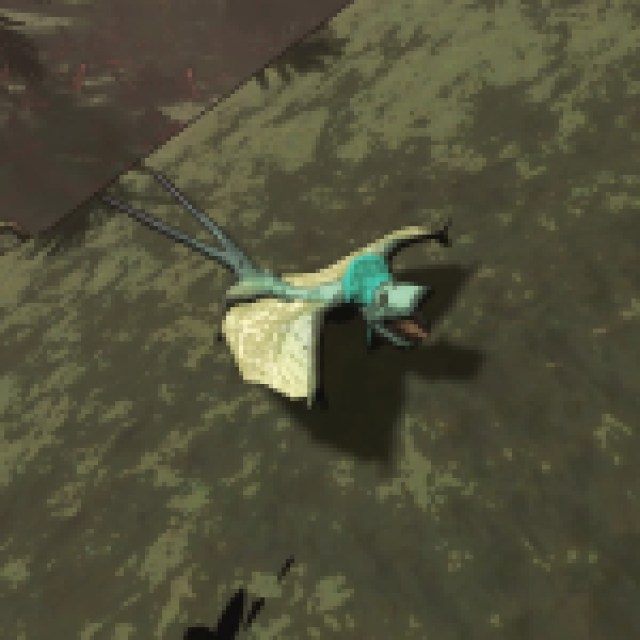

Tulip Snakes are the other outdoor entities introduced in the new update. These are small creatures with wings that latch onto the player’s head and lift them in the air.
You can deem them as the only helpful monsters in the game as they don’t attack you. You can use them to fly around the map when more than one of them latches onto you. The mechanics are similar to that of a Jetpack, the only difference being that you can’t control the height at which you fly in the air.
You can also kill them with one hit from a shovel, regardless of how many of them are attached to you. However, at some point, they will drop you from the sky, and you will get fall damage, so be careful of your player’s health.
Bestiary Entry for Tulip Snakes
“Tulip snakes, or tulip lizards, are a type of flying lizard which are easily distinguished by their long arms and wings, which can reach twice the size of other members of their genus (Draco) and sport unusually bright colors and patterns. Their name comes from the flaps under their neck and behind their head, which resemble large flower petals. (Their other unusual characteristics include an extra pair of eyes and a deeply forked tail.)
Their behaviour is stubborn and fearless to a fault. Indeed, tulip snakes will rarely flee a predator. But ironically, many biologists theorize that their flowery appearance aids them more as a camoflauge than an intimidation display. It also takes an important part in their elaborate courtship rituals, which are more similar to that of birds.
Uniquely, lifting heavy and large objects into the air has often been observed as a part of the tulip snake’s mating display; they are capable of carrying rocks and plants at least twice their size in an effort to impress their potential mate. Protective, jealous, and in a frenzy, the males may end up tug-of-war fights over objects they take a liking to, which can even include other living creatures.”





Published: Apr 26, 2024 12:08 pm